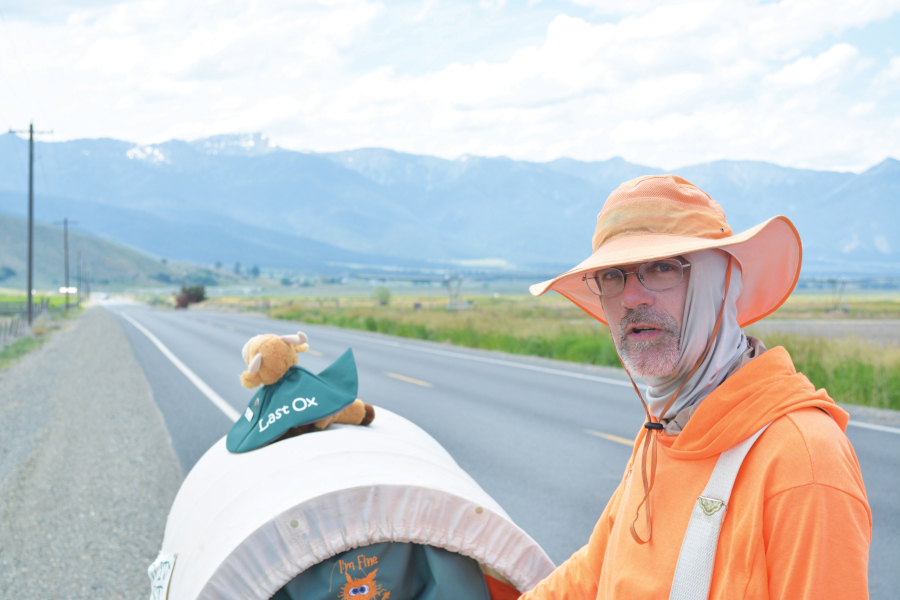Hundreds of thousands of people traveled the Oregon Trail in the 19th century, and Don “Dundee” Martin is honoring their journey.
Like his pioneer counterparts, Martin travels with a wagon and an ox.
He eats Oregon Trail foods — steel cut oats, rice, nuts and dried meats and fruits.
He wears traditional pioneer white canvas pants with suspenders, camps in thunderstorms and carries enough water to last him a week.
But unlike those of his forebears, Martin’s wagon is a single-wheeled cart — aesthetically similar to a pioneer wagon, covered in canvas supported by curved oak beams.
And instead of pulling the cart, his ox is a stuffed toy that rides on top of the wagon.
Martin passed through Baker City on Wednesday, July 6 as he attempts to walk the entire historic Oregon Trail.
He stayed overnight at the home of friends Carla and Wayne Inman, and then took a rest day on Thursday.
Besides his cart and his stuffed ox, Martin — who lives in Prineville — has different motivations than the 19th century travelers bent on settling in a new land.
Martin said he’s walking the trail as a cultural and historical pilgrimage.
“A pilgrimage is an opportunity to get away from your day to day life, do something physically demanding that you would not otherwise be doing, share experiences with fellow travelers, get a different sense of perspective and do some self reflection,” Martin said. “There’s a lot of good things that come out of it.”’
On Wednesday Martin strode west on the shoulder of Pocahontas Road, facing the Elkhorns, gripping the leather-wrapped handlebars of his cart with fingerless gloves.
His outfit was a mix of 19th century farmer, long distance hiker and deer hunter — those traditional white pants, with an orange long-sleeve shirt and floppy orange hat, for visibility.
His pants were tucked into wool socks inside hiking sneakers, the foam heel squashed, the tread deeply worn.
Martin is on his third pair of shoes out of the four he brought. Now 2,075 miles and 81 days into the trip, he hopes the fourth pair will get him through the final 400 miles to Oregon City.
A modern accessory
Attached to the front of the cart is a device that Oregon Trail pioneers could scarcely have imagined — a Garmin GPS unit, which tracks his mileage and provides a location tracker where people can follow along online.
Martin’s wagon — nicknamed “Ollie,” as in “ollie, ollie oxen free” — like 19th century prairie schooners contains everything he needs to live for weeks on remote parts of the trail.
Unfortunately, though, the wagon, he said, has “zero capability in mud.”
“There’s still Kansas mud in that thing,” Martin said.
He also carries camping gear. He usually can find public land to camp on, but if he can’t, he’ll just start knocking on doors.
“Most people that know what you’re doing are happy to share their yard for a night,” Martin said. “If you look, generally there’s a place where you can stay.”
Martin said one of the “high points” of his pilgrimage is meeting new people, “trading stories with them, just talking to them, hopefully inspiring a little more interest in the trail.”
A trail (re)blazer
Martin’s journey started on April 16 in Independence, Mo., a common jumping-off point for westbound immigrants. Since then he’s passed through Kansas, Nebraska, Wyoming and Idaho.
It’s a long walk, but Martin said that’s not the reason so few people complete — or even attempt — the hike today.
Other long-distance hikes in the West are longer, like the Pacific Crest Trail or the Continental Divide Trail, but are frequented by hundreds of hikers a year.
Those routes are designated for hikers and horseback riders, and unlike the Oregon Trail, they haven’t been supplanted by highways.
Over 3,000 people per year attempt an Appalachian Trail “thru hike” — completing the entire trail in one year — which Martin completed previously and is about the same length as the Oregon Trail.
Last year, 451 people summited Mount Everest in the Himalayas. But Martin said he knows of fewer than 10 who have walked the entire Oregon Trail since modern roads were constructed.



